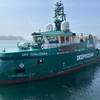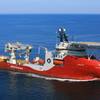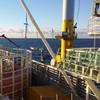KEMA Collaborates on Offshore Energy Storage System
The Energy Island designed by KEMA, Lievense and the Das brothers incorporates a new concept in pumped hydro storage – an inverse offshore pump accumulation station (IOPAC). On the Energy Island when there is a surplus of wind energy, the excess energy is used to pump sea water out of the interior ‘subsurface-lake’ into the surrounding sea. When there is a shortage of wind power, sea water is allowed to flow back into the interior ‘lake’ through commercially available generators to produce energy. The IOPAC is unique from conventional pumped hydro storage systems in that it would be stationed on an artificial island off the Dutch coast in the North Sea and comprised of a ring of dikes surrounding a 50 meter deep reservoir. The island itself would be built from materials dredged to deepen the interior reservoir.
KEMA analysis estimates that the proposed Energy Island storage system would have a maximum generation capacity of 1,500 MW, depending on the water level. It also would have an annual storage capacity of more than 20 GWh – enough energy to offset 500 to 840 kilotons of CO2 emissions. In the next phase of the feasibility study underway KEMA is further analyzing the costs and benefits of additional regulating reserve, download wind power, CO2 reduction, and environmental impact. Utilizing stored energy can help reduce the overall amount of CO2 emissions associated with electricity production, especially when combined with wind or other renewable energy resources. Investment in large scale energy storage can increase the efficiency of conventional power plants as well as offset investments in replacing or developing new conventional peak production capacity. In addition to providing an alternative for large scale electricity storage, the energy island concept has the potential to provide coastal protection, harbor and/or LNG terminal facilities, aquatic biomass, and eco-tourism opportunities. Construction of the energy island is dependent on seabed composition. The North Sea site studied includes a seabed with a thick layer of clay. The US is actively developing advanced energy storage technologies and systems through public-private partnership programs such as the US Department of Energy (DOE) Energy Storage System Program. Technologies in development include various battery systems, advanced flywheels, superconductivity, compressed air, and pumped hydro. The Energy Island concept is an important step forward in demonstrating the role of large-scale energy storage in enhancing the reliability of the power supply, stabilizing the cost of electricity, and reducing CO2 emissions.







